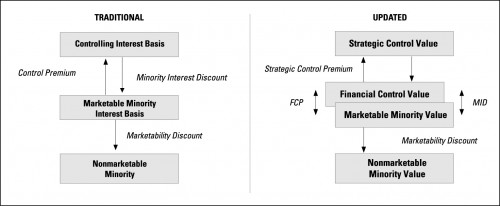What Kind of Value is Statutory Fair Value?: Kentucky Supreme Court Provides Guidance
In 2012, Chris Mercer, CEO, wrote about a recent appellate level case in Kentucky addressing the question of statutory fair value in Kentucky. Given several recent conversations with Kentucky clients, a revisit of that case is appropriate.
For further information about statutory fair value, see this e-book by Chris Mercer.
In the case, Shawnee Telecom Resources, Inc. v. Kathy Brown, the Kentucky Supreme Court provides a number of interesting insights into the evolution of statutory fair value in the various states, and, in this matter, in Kentucky.
A Bit of Kentucky History
Kentucky has had an interesting history regarding statutory fair value. For many years, the leading case on the issue was a Court of Appeals decision in Ford v. Courier-Journal Job Printing Co., 639 S.W.2d 553 (Ky App. 1982). This case allowed the application of a 25% marketability discount, and was the reigning precedent for nearly thirty years.
The Ford case was overruled by another Court of Appeals decision in Brooks v. Brooks Furniture Mfgrs., Inc. 325 S.W.3d 904 (Ky. App. 2010). The Court of Appeals explicitly overruled Ford with respect to the application of the marketability discount. However, the Court of Appeals also rejected the use of the net asset value method. Enter the Kentucky Supreme Court:
The case before us presents squarely the broad issue of “fair value” and the more specific issues of the continuing viability of a marketability discount in a dissenters’ rights appraisal action and the appropriateness of valuing closely held corporate stock under the net asset method. Having thoroughly considered the statute [Subtitle 13 of the Kentucky Business Corporation act, Kentucky Revised Statutes (KRS) Chapter 271B] and its underlying purpose, we conclude that “fair value” is the shareholder’s proportionate interest in the value of the company as a whole and as a going concern. Any valuation method generally recognized in the business appraisal field, including the net asset and the capitalization of earnings methods employed in this case can be appropriate in valuing a given business….[emphasis added]
Fair Value Is Enterprise Value
What is fascinating about this case is that the Kentucky Supreme Court seems not only to have understood the concepts underlying what we in the business appraisal profession call the levels of value, but also reflected that understanding in clearly written prose. The levels of value charts are shown below:
The traditional, three-level chart is shown on the left. The chart that is generally recognized by most writers in the field now is the four-level chart on the right. The levels at (or) above that of the marketable minority level are referred to as enterprise or entity levels of value. Values at the enterprise levels are developed based on the expected cash flows, risks and expected growth of the enterprises, or as noted above, “the value of the company as a whole and as a going concern.”
The level below that of marketable minority is the nonmarketable minority level of value. This is the shareholder level of value. Value at this level is based on the expected cash flows, risks and expected growth pertaining to a particular shareholder’s interest in the business. Intuitively, most people recognize that the value of an illiquid minority interest in a business is most often worth less than that interest’s proportionate share of enterprise value.
The Kentucky Supreme Court understands the distinction, as is clear in the following:
As for applying a marketability discount when valuing the dissenter’s shares, we join the majority of jurisdictions which, as a matter of law, reject this shareholder-level discount because it is premised on fair market value principles which overlook the primary purpose of the dissenters’ appraisal right — the right to receive the value of their stock in the company as a going concern, not its value in a hypothetical sale to a corporate outsider. However, generally recognized entity-level discounts, where justified by the evidence are appropriate because these are factors that affect the intrinsic value of the corporate entity as a whole. [emphasis added]
Fair Value Is Not Shareholder Level Value
This language regarding entity level valuation is consistent with the recent case I wrote about from the South Dakota Supreme Court. The post was titled Statutory Fair Value (South Dakota): Customer Risk Consideration is not a Valuation Discount. The point of that case was that it is inappropriate to lump entity-level adjustments into so-called valuation discounts like the minority interest discount or the marketability discount.
The Kentucky Supreme Court reviewed a good bit of history pertaining to statutory fair value. In so doing, a number of important points were made to clarify the meaning of fair value in Kentucky.
Because an award of anything less than a fully proportionate share would have the effect of transferring a portion of the minority interest to the majority, and because it is the company being valued and not the minority shares themselves as a commodity, shareholder level discounts for lack of control or lack of marketability have also been widely disallowed.
Fair value should be determined using the customary valuation concepts and techniques generally employed in the relevant securities and financial markets for similar businesses in the context of the transaction giving rise to appraisal (quoting Principles of Corporate Governance: Analysis and Recommendations § 7.22(a) (ALI 1994))
…[W]e find a broad consensus among courts, commentators, and the drafters of the Model Act that “fair value” in this context is best understood, not as a hypothetical price at which the dissenting shareholder might sell his or her particular shares, but rather as the dissenter’s proportionate interest in the company as a going concern.
Because a hypothetical market price for the dissenter’s particular shares as a commodity is thus not the value being sought, market adjustments to arrive at such a price, such as discounts for lack of control or lack of marketability, are inappropriate.
An Amicus Brief was filed by the Kentucky Chamber of Commerce that suggested that dissenting shareholders might obtain a windfall in an appraisal proceeding if the typical valuation discounts were not applied. The logic was that there would be a likelihood that the minority shareholder purchased his or her shares at a discounted level and that if they were bought out at undiscounted levels, there could be a windfall to them. This logic was dismissed by the court. Dissenters are not voluntary participants in transactions, and therefore need to be protected.
The court also found that the net asset value method, appropriately considered in the value of an enterprise, was an appropriate valuation method.
Entity-Level Discounts Are Appropriate
The Kentucky Supreme Court was specific that entity-level discounts, where supported by the evidence, are acceptable. Shawnee argued that, if a marketability discount was not allowable at the shareholder level, one should be available at the entity level. The court was wary of this argument, stating:
We agree [that a marketability discount at the entity level could be applicable] but with the strong caveat, that any entity level discount must be based on particular facts and authority germane to the specific company being valued, i.e., there can be no automatic 15-25% discount of the whole entity’s value simply because it is closely held and not publicly traded.
The court listed a number of “recognized entity-level discounts” that could be appropriate in specific circumstances, including a key manager discount, a limited customer [see the South Dakota Supreme Court’s analysis of this one] or supplier base discount, a built-in capital gains discount, a “portfolio” discount, a small size discount or a privately held company discount.The court referred to Shannon Pratt’s book, Business Valuation Discounts and Premiums when discussing this list of discounts.
Immediately following this list of entity-level discounts, the court emphasized the distinction between entity-level and shareholder-level discounts, which I quote because of the importance of the discussion:
As noted above, the distinction between entity-level and shareholder-level discounts is recognized in the business valuation literature, Shannon P. Pratt, Business Valuation Discounts and Premiums, p. 3 (2001) [linked above], and was referred to in Cavalier, where the Court observed that shareholder-level discounts, such as those for lack of control and lack of marketability, tend to defeat the protective purpose of the appraisal remedy by transferring a portion of the dissenter’s interest in the company to the majority. Entity-level discounts, on the other hand, take into account those factors, such as a company’s reliance on a key manager, that affect the value of the company as a whole…”Cavalier authorized corporate level discounting as a means of establishing the intrinsic value of the enterprise.” Where such entity-level adjustments are proper, they should be incorporated into the valuation technique employed, and the appraiser should be able to cite the relevant facts and authority for making the adjustment. (emphasis added)
The Court then discussed the Delaware Chancery Court’s rejection of “the sort of marketability discount that the court applied.” Borruso v. Communications Telesystems International, 753 A.2d 451 (Del. Ch. 1999). While holding that an appraiser might properly support a discount based on privately held companies selling at lower multiples than publicly traded companies, the court found that there was insufficient evidence to support the discount applied. The court cited, among other things, my article “Should Marketability Discounts Be Applied to Controlling Interests in Companies?” in the June 1994 edition of Business Valuation Review [subscription required. Email me if you’d like a copy].
As if to hammer the point home, the Court stated:
On remand, Shawnee is free to present evidence tending to show that its going concern value is lessened by such factors as its small size and its private nature, but otherwise it is not entitled to a discount based simply on the generally perceived lack of marketability of closely held corporate shares.
Conclusion
The conclusion of Shawnee is instructive:
In sum, we agree with the Court of Appeals that Ford [applying a marketability discount] has outlived its usefulness and does not provide a suitable interpretation of the appraisal remedy currently available under KRS Subchapter 271B.13. under that subchapter, a properly dissenting shareholder is entitled to the “fair value” of his or her shares, which is the shareholder’s proportionate interest in the value of the company as a whole as a going concern. Going concern value is to be determined in accord with the concepts and techniques generally recognized and employed in the business and financial community. Although the parties may, and indeed are encouraged to, offer estimates of value derived by more than one technique, the trial court is not obliged to assign a weight to or to average the various estimates, but may combine or choose among them as it believes appropriate given the evidence. If the particular technique allows for them, adequately supported entity-level adjustments may be appropriate to reflect aspects of the company bearing positively or negatively on its value. Once the entire company has been valued as a going concern, however, by applying an appraisal technique that passes judicial muster, the dissenting shareholder’s interest may not be discounted to reflect either a lack of control or a lack of marketability….
A careful reading of this case indicates that the Kentucky Supreme Court warns courts (and appraisers) that shareholder-level discounts disguised as entity-level adjustments are not appropriate.
In terms of the levels of value chart above, fair value in Kentucky could be interpreted to be the functional equivalent of fair market value at the entity-, or enterprise level. What is not clear, however, is whether the Kentucky Supreme Court would embrace valuation in dissenters’ rights matters at the strategic control level. The case addressed protections afforded by the Kentucky statute to dissenting, generally minority, shareholders. There was no discussion of taking into account any potential synergies that might occur in a strategic or synergistic sale of the business.
Perhaps, the answer lies in the language used in a conclusory statement noted above:
… we conclude that “fair value” is the shareholder’s proportionate interest in the value of the Company as a whole and as a going concern.
If a company is valued “as a whole” and as a “going concern,” it may be difficult to argue that the implied combination with another entity in a strategic valuation is appropriate.
The Court is clear that there can be no downward bias from entity-level valuation to the shareholder level of valuation in Shawnee. However, the issue of any upward bias in statutory fair value determinations was not addressed in the case.
Originally published on ChrisMercer.net | October 19, 2017




